Archaeology
![]()
Archaeological Discoveries and the Invasion of Judah
Psalm 137:5-6 "If I forget you, O Jerusalem, Let my right hand forget its skill! If I do not remember you, Let my tongue cling to the roof of my mouth -- If I do not exalt Jerusalem Above my chief joy."
![]()
The Babylonian Chronicles
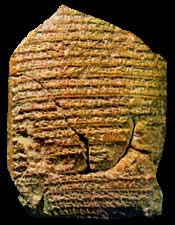
The Babylonian Chronicles make it possible to assign the fall of Jerusalem to the Second of Adar (March 16) in 597 B.C. with complete accuracy, confirming the Biblical accounts of Babylonian attacks on Jerusalem in 597 and 586 B.C.
The Babylonian Chronicle records:
"In the seventh month (of Nebuchadnezzar-599 BC.) in the month Chislev (Nov/Dec) the king of Babylon assembled his army, and after he had invaded the land of Hatti (Syria/Palestine) he laid seige to the city of Judah. On the second day of the month of Adara ( 16th of March) he conquered the city and took the king (Jehoiachin) prisoner. He installed in his place a king (Zedekiah) of his own choice, and after he had received rich tribute, he sent (them) forth to Babylon."
When comparing this text from ancient Babylon with the record of the Babylonian invasion in the Book of II Kings 24:7-17 they demonstrate very clearly the accuracy of the Biblical text.
Lachish Letters
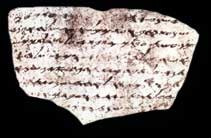
Important light has been revealed regarding the last days of Judah by the discovery in 1935 of eighteen ostraca (clay tablet with writing in ink) written in an ancient cursive script belonging to the seventh century B.C.
They were discovered at Lachish (Tell ed-Duweir) among the ruins of a small guard room just outside the city gate. Then a few years later three inscribed potsherds were also found at the site, and like the others, they contained names and lists from the period just before the fall of Jerusalem in 586 B.C.
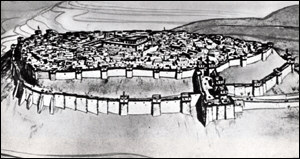
Most of the letters were dispatches from a Jewish commander named Hoshaiah who was stationed at an outpost north of Lachish, who apparently was responsible for interpreting the signals from Azekah and Lachish during the time when the:
Jer 34:7 "when the king of Babylon's army fought against Jerusalem and all the cities of Judah that were left, against Lachish and Azekah; for only these fortified cities remained of the cities of Judah."
These final communications which mentioned the political and religious turmoil of the last days of Judah reveal the intensity of this time period and confirm that which was written in the Bible by the prophet Jeremiah.
Jehoiakin Inscription
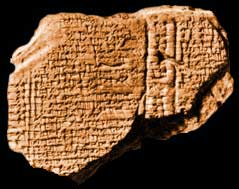
This is one of the clay tablets that reveal the presence of the Judean royal house as prisoners in Babylon. They were excavated from an arched building near the Ishtar Gate of ancient Babylon. The cuneiform texts, which are dated between 595 and 570 B.C., contain lists of rations of barley and oil issued to the captive princes and artisans, including "Yaukin, king of the land of Yahud." This is a direct reference to Jehoiachin, and some of the other tablets also mentioned his 5 sons who accompanied him to Babylon. (Staatliche Museum, Berlin).
Eliakim Seal
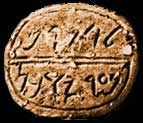
This seal bears the inscription "The property of Eliakim, steward of Jehoiakin." It is from Debir (Tell Beit Mirsim) located 13 miles southwest of Hebron. It was excavated by William F. Albright in 1926.
Gedaliah Seal
This seal was found at Lachish and bears the inscription "Gedaliah, who is over the house." Gedaliah was the name of the man who the Babylonians had appointed as governor of Judah after the destruction of Jerusalem.
(See Jeremiah's Prophecies)
![]()
Read The Bible
- 1599 Geneva Bible (GNV)
- 21st Century King James Version (KJ21)
- American Standard Version (ASV)
- Amplified Bible (AMP)
- Amplified Bible, Classic Edition (AMPC)
- Authorized (King James) Version (AKJV)
- BRG Bible (BRG)
- Christian Standard Bible (CSB)
- Common English Bible (CEB)
- Complete Jewish Bible (CJB)
- Contemporary English Version (CEV)
- Darby Translation (DARBY)
- Disciples’ Literal New Testament (DLNT)
- Douay-Rheims 1899 American Edition (DRA)
- Easy-to-Read Version (ERV)
- English Standard Version (ESV)
- English Standard Version Anglicised (ESVUK)
- Evangelical Heritage Version (EHV)
- Expanded Bible (EXB)
- GOD’S WORD Translation (GW)
- Good News Translation (GNT)
- Holman Christian Standard Bible (HCSB)
- International Children’s Bible (ICB)
- International Standard Version (ISV)
- J.B. Phillips New Testament (PHILLIPS)
- Jubilee Bible 2000 (JUB)
- King James Version (KJV)
- Lexham English Bible (LEB)
- Living Bible (TLB)
- Modern English Version (MEV)
- Mounce Reverse Interlinear New Testament (MOUNCE)
- Names of God Bible (NOG)
- New American Bible (Revised Edition) (NABRE)
- New American Standard Bible (NASB)
- New American Standard Bible 1995 (NASB1995)
- New Catholic Bible (NCB)
- New Century Version (NCV)
- New English Translation (NET)
- New International Reader's Version (NIRV)
- New International Version - UK (NIVUK)
- New International Version (NIV)
- New King James Version (NKJV)
- New Life Version (NLV)
- New Living Translation (NLT)
- New Matthew Bible (NMB)
- New Revised Standard Version (NRSV)
- New Revised Standard Version Catholic Edition (NRSVCE)
- New Revised Standard Version, Anglicised (NRSVA)
- New Revised Standard Version, Anglicised Catholic Edition (NRSVACE)
- New Testament for Everyone (NTE)
- Orthodox Jewish Bible (OJB)
- Revised Geneva Translation (RGT)
- Revised Standard Version (RSV)
- Revised Standard Version Catholic Edition (RSVCE)
- The Message (MSG)
- The Voice (VOICE)
- Tree of Life Version (TLV)
- World English Bible (WEB)
- Worldwide English (New Testament) (WE)
- Wycliffe Bible (WYC)
- Young's Literal Translation (YLT)
Table of Contents
- Introduction
- Overview
- Fall of Jerusalem
- Scriptures
- Dictionaries and Encyclopedias
- Timeline of Events
- Archaeology
- 1 - Babylonian Forces Approaching
- 2 - Capture of Judean Cities
- 3 - The Siege of Jerusalem
- 4 - Edomites Raid Judah
- 5 - Rumor of Approaching Egyptian Forces
- 6 - Jerusalem is Captured
- 7 - King Zedekiah Tries to Flee
- 8 - Jews Deported to Babylon from Ramah
- Jeremiah's Prophecies
Main Menu
- Ancient Assyrian Social Structure
- Ancient Babylonia
- Ancient Canaan During the Time of Joshua
- Ancient History Timeline
- Ancient Oil Lamps
- Antonia Fortress
- Archaeology of Ancient Assyria
- Assyria and Bible Prophecy
- Augustus Caesar
- Background Bible Study
- Bible
- Biblical Geography
- Fallen Empires - Archaeological Discoveries and the Bible
- First Century Jerusalem
- Glossary of Latin Words
- Herod Agrippa I
- Herod Antipas
- Herod the Great
- Herod's Temple
- High Priest's in New Testament Times
- Jewish Literature in New Testament Times
- Library collection
- Map of David's Kingdom
- Map of the Divided Kingdom - Israel and Judah
- Map of the Ministry of Jesus
- Matthew Henry Bible Commentary
- Messianic Prophecy
- Nero Caesar Emperor
- Online Bible Maps
- Paul's First Missionary Journey
- Paul's Second Missionary Journey
- Paul's Third Missionary Journey
- Pontius Pilate
- Questions About the Ancient World
- Tabernacle of Ancient Israel
- Tax Collectors in New Testament Times
- The Babylonian Captivity
- The Black Obelisk of Shalmaneser
- The Books of the New Testament
- The Court of the Gentiles
- The Court of the Women in the Temple
- The Destruction of Israel
- The Fall of Judah with Map
- The History Of Rome
- The Incredible Bible
- The Jewish Calendar in Ancient Hebrew History
- The Life of Jesus in Chronological Order
- The Life of Jesus in Harmony
- The Names of God
- The New Testament
- The Old Testament
- The Passion of the Christ
- The Pharisees
- The Sacred Year of Israel in New Testament Times
- The Samaritans
- The Scribes
Ancient Questions
- Why Do the Huldah Gates Appear Different in Ancient Replicas and Modern Photos?
- What Is the Origin of the Japanese and Chinese Peoples? A Biblical Perspective
- How did the ancient Greeks and Romans practice medicine and treat illnesses?
- What were the major contributions of ancient Babylon to mathematics and astronomy?
- How did the ancient Persians create and administer their vast empire?
- What were the cultural and artistic achievements of ancient India, particularly during the Gupta Empire?
- How did ancient civilizations like the Incas and Aztecs build their remarkable cities and structures?
- What were the major trade routes and trading practices of the ancient world?
- What was the role of slavery in ancient societies like Rome and Greece?
- How did the ancient Mayans develop their sophisticated calendar system?
Bible Study Questions
- Why Do Christians Celebrate Christmas?
- How Many Chapters Are There in the Bible?
- The Five Key Visions in the New Testament
- The 400-Year Prophecy: Unpacking Genesis 15 and the Journey of a People
- The Authorized (King James) Version (AKJV): Historical Significance, Translation Methodology, and Lasting Impact
- Exploring the English Standard Version (ESV): Its Aspects, Comparisons, Impact on Biblical Studies, and Church Use
- A Detailed Historical Analysis of Language Updates in the KJ21: Comparison with Other Versions
- A Detailed Historical Analysis of the American Standard Version (ASV): Comparison to the King James Version, Influence on Later Translations, and Evaluation of Strengths and Weaknesses
- A Detailed Historical Analysis of Amplifications in the Amplified Bible (AMP) and Its Comparison to Other Bible Translations
- Detailed Historical Analysis of the Amplified Bible Classic Edition (AMPC): Examples of Amplifications and Comparative Analysis with Other Bible Translations
About
Welcome to Free Bible: Unearthing the Past, Illuminating the Present! Step into a world where ancient history and biblical narratives intertwine, inviting you to explore the rich tapestry of human civilization.
Discover the captivating stories of forgotten empires, delve into the customs and cultures of our ancestors, and witness the remarkable findings unearthed by dedicated archaeologists.
Immerse yourself in a treasure trove of knowledge, where the past comes alive and illuminates our understanding of the present.
Join us on this extraordinary journey through time, where curiosity is rewarded and ancient mysteries await your exploration.
Recent posts
-

Modern Christian Abstract Art Canvas Prints | Artesty
Modern Christian Abstract Art: Contemporary Spiritual Wall Art for a Modern Home Modern Christian art makes it easier to bring faith into everyday spa... -

Best Paphos property developers (and how to choose the right one)
Buying property in Paphos is one of the most popular real-estate decisions in Cyprus, whether the goal is relocation, lifestyle living, or long-term i... -

CQR Pants vs 5.11 Tactical: My Honest Review After Hiking the Jesus Trail and Via Dolorosa
After walking 65 kilometers through the Galilee hills and navigating Jerusalem's ancient stone streets, I can tell you exactly which tactical pants su... -

Finding the right services for immigrants in the United States
As we understand, life for immigrants in the United States can be challenging, especially in the early stages. Once you have solved the most important... -

Onigiri packaging for retailers and cafés
Onigiri packaging for retailers and cafés plays a crucial role in preserving freshness, ensuring food safety, and enhancing product presentation. As ...